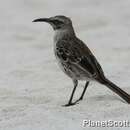Biology
provided by Arkive
The hood mocking bird is remarkably fearless of humans, and it is not uncommon for one to land on the head of a visitor to the island (3) (4). It will eagerly explore any unknown object for food or drink (4), and the result of this behaviour is an incredibly varied diet. It will feed on typical items such as insects, fruits, berries, marine arthropods and small vertebrates, but will also eat carrion from carcasses of seabirds, lizards and sea lions. Damaged seabird eggs are promptly consumed, and it will also use its powerful bill to eat intact eggs, and pluck ticks from the backs of marine and land iguanas. A unique feature of this species is its blood-drinking habit; it customarily drinks blood, especially in the dry season, from wounds in living sea lions, from sea lion placentas, and even from wounds on the legs of humans (2).
The hood mockingbird is territorial, with seven to ten adults per territorial group, but often only one breeding pair (2). The hood mockingbird is a co-operative breeder, meaning that non-breeders act as helpers at nests in their group's territory, and some breeders help raise nestlings in nests other than their own (3). The cup-shaped nest, made of twigs and lined with finer plant material, is often placed in a cactus. Breeding occurs from March to April when clutches of one to four eggs are laid, with the resulting chicks being fed by several adults (2). In the non-breeding season, hood mockingbirds gather in groups of up to 40 individuals, which forage together (5)
Conservation
provided by Arkive
At present, there are no introduced predators on either island inhabited by the hood mockingbird, and efforts should be made to reduce the chance of this ever occurring, as well as minimising the risk of any disease being introduced to the population (2) (5). Whilst the hood mockingbird is not known to be receiving any specific conservation attention, the Galápagos Islands are designated a National Park and a World Heritage Site (6). This, along with the Ecuadorian Government and the international conservation community recognizing the importance of protecting the islands' biodiversity, should offer this fascinating bird the protection it requires from any potential threats.
Description
provided by Arkive
The inquisitive, blood-drinking hood mockingbird is the largest of all the mockingbirds in the Galápagos Islands (3). It has a very long bill that curves downwards, and yellowish-brown eyes surrounded by a dark patch. The feathers of the upperparts have blackish-brown centres and grey to brownish-grey margins, giving the plumage a streaked or scalloped appearance (2). The whitish underparts have indistinct brown markings on the breast, and streaks on the flanks. The long, graduated tail is dark brown on top, and whitish underneath. The sexes are similar in their plumage, but the female is slightly smaller than the male. The hood mockingbird has a lengthy and strident song (2).
Habitat
provided by Arkive
Inhabits arid lowland scrub, low thorny mesquite scrub, and deciduous woodland (2).
Range
provided by Arkive
The hood mockingbird is endemic to the Galápagos Islands, where it occurs only on the islands of Española and Gardner-by-Española (2).
Status
provided by Arkive
Classified as Vulnerable (VU) on the IUCN Red List (1).
Threats
provided by Arkive
The restricted range of the hood mockingbird is an intrinsic threat to the species. Events such as extreme weather, or an introduced predator, could rapidly affect the entire species, with devastating consequences (2) (5).

